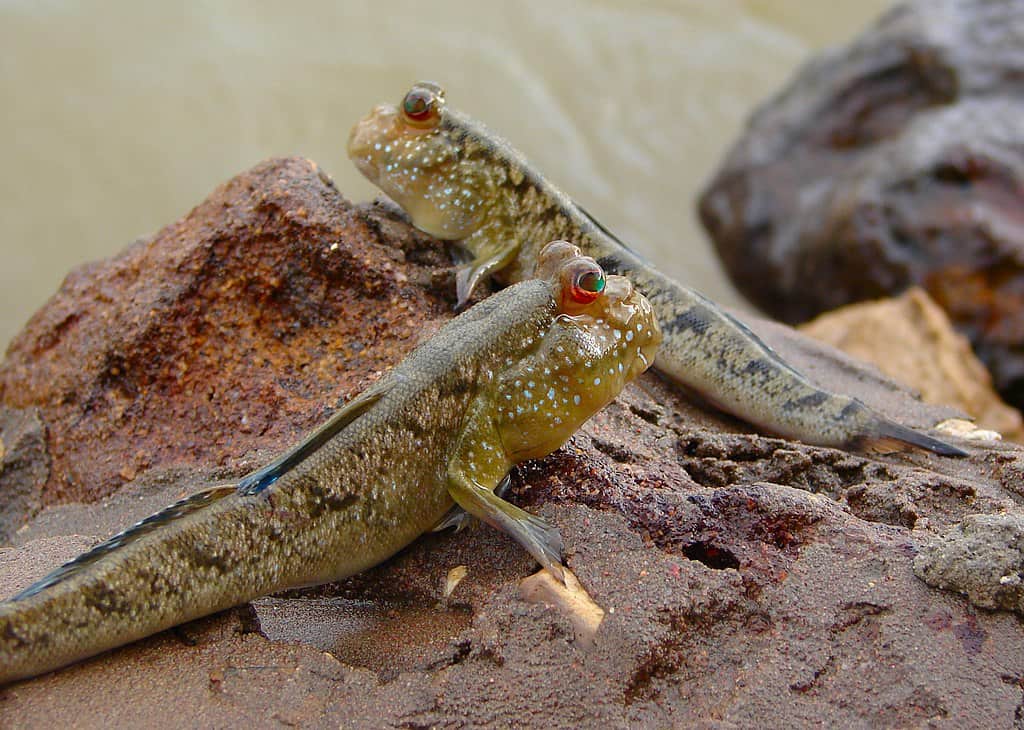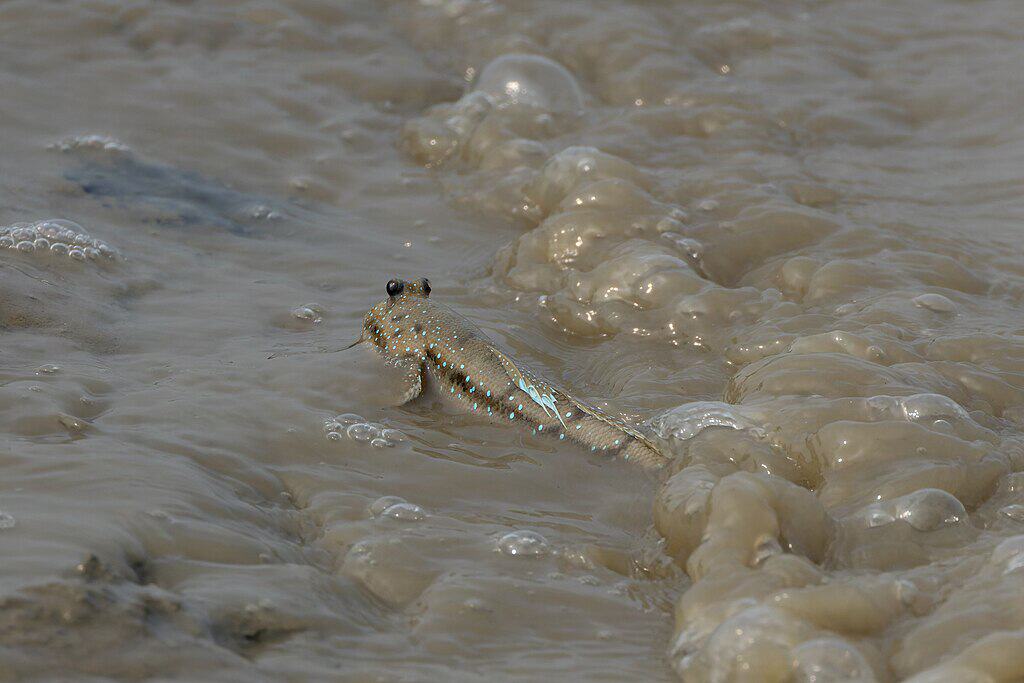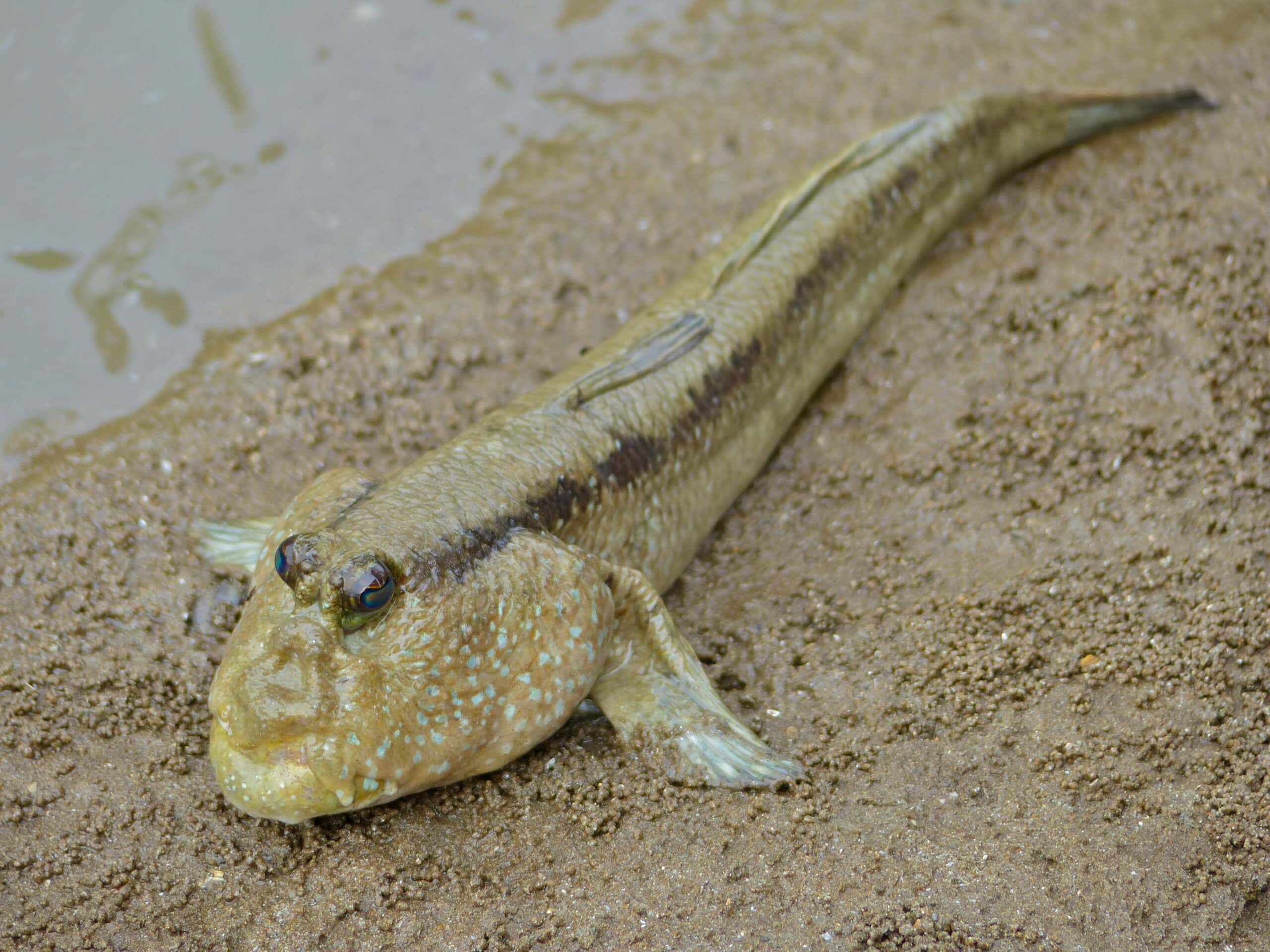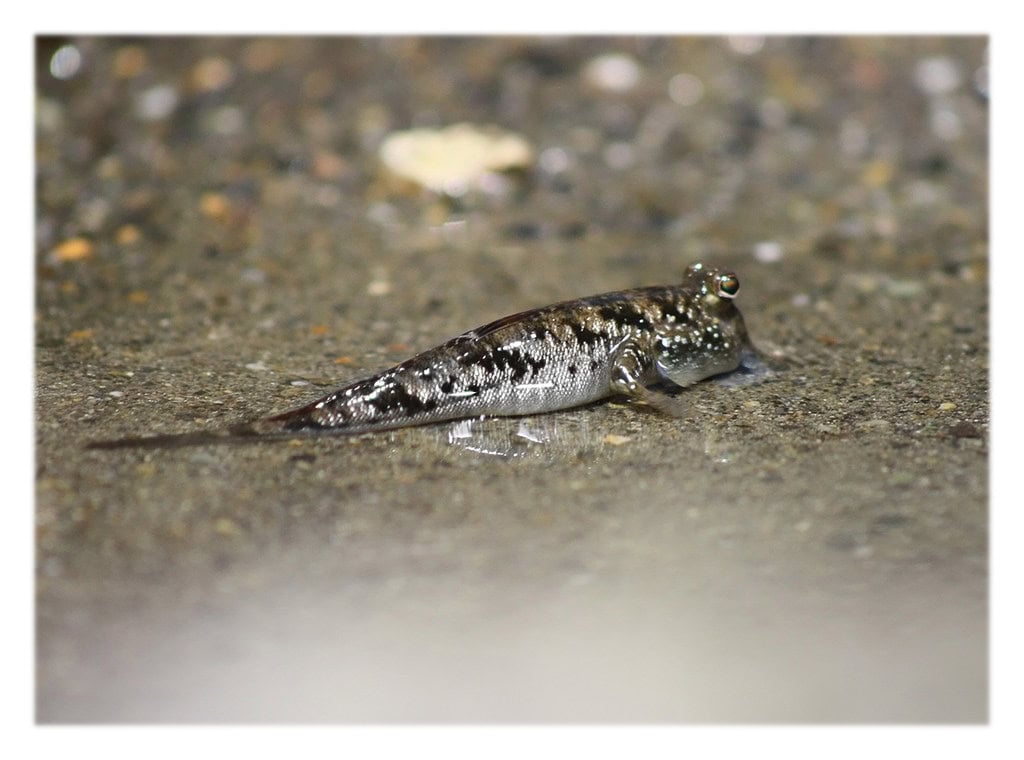In the fascinating world of marine biology, there exists a remarkable creature that defies conventional understanding of fish behavior. Mudskippers, the amphibious fish that can breathe and walk on land, represent one of evolution’s most intriguing adaptations. These extraordinary creatures spend up to 90% of their lives out of water, challenging our perception of what fish can do. With their distinctive bulging eyes, muscular pectoral fins, and ability to breathe through their skin, mudskippers have captivated scientists and nature enthusiasts alike. This article explores the remarkable adaptations, behaviors, and ecological significance of these walking fish that have successfully conquered both aquatic and terrestrial environments.
What Are Mudskippers? An Evolutionary Marvel

Mudskippers belong to the Oxudercinae subfamily within the Gobiidae family, comprising approximately 32 species across four genera: Boleophthalmus, Periophthalmodon, Periophthalmus, and Scartelaos. These extraordinary fish evolved from fully aquatic ancestors and developed remarkable adaptations that allow them to thrive in the challenging intertidal zones of mangrove forests, mudflats, and estuaries across the Indo-Pacific region, from Africa to Australia and Japan.
Their evolutionary journey represents a fascinating example of how aquatic species can adapt to terrestrial environments, making them living models of the evolutionary transition that occurred when ancient fish began to colonize land millions of years ago. While not directly related to the ancient fish that gave rise to tetrapods, mudskippers demonstrate convergent evolution in developing similar adaptations for terrestrial life.
The Unique Anatomy That Enables Land Movement

Mudskippers possess several anatomical adaptations that facilitate their amphibious lifestyle. Their most distinctive feature is their modified pectoral fins, which have evolved into arm-like appendages with strong muscles and a distinctive elbow-like joint. These specialized fins allow them to “walk” across mud with a crutching motion or even climb mangrove roots. Their pelvic fins have also adapted to function as a suction cup that provides stability when resting on slippery surfaces.
Additionally, mudskippers have powerful, muscular tails that they use to propel themselves in leaping motions, capable of jumping distances of up to 60 cm—an impressive feat for a fish typically measuring between 10-25 cm in length. Their streamlined body shape, with a flattened underside, facilitates movement across muddy surfaces while minimizing friction and energy expenditure.
Breathing Air: Respiratory Adaptations

Perhaps the most remarkable aspect of mudskippers is their ability to breathe atmospheric oxygen. Unlike most fish that would suffocate out of water, mudskippers have evolved multiple respiratory mechanisms to thrive in air. Their enlarged gill chambers can retain water, functioning as a primitive lung that allows gas exchange to continue when exposed to air. Many species also perform cutaneous respiration, absorbing oxygen directly through their skin, which must remain moist to function effectively.
Additionally, some mudskippers have developed specialized blood vessels near their skin surface to enhance oxygen uptake. These fish regularly gulp air at the water’s surface, a behavior that continues when they’re on land. Their ability to extract oxygen from both water and air gives them a significant advantage in oxygen-depleted environments like mudflats, where water can become hypoxic (low in dissolved oxygen) during hot periods or at low tide.
Vision Adaptations for Dual Environments

Mudskippers possess one of the most advanced visual systems among fish, perfectly adapted for their amphibious lifestyle. Their bulging eyes sit atop their heads like periscopes, providing nearly 360-degree vision that helps them spot predators approaching from virtually any direction. These protruding eyes can be retracted into special sockets when the fish dives into mud or water, protecting them from damage.
Unlike most fish, mudskippers have adaptable vision that works well both underwater and in air—a remarkable feat considering the different refractive properties of these media. Their eyes contain specialized tear glands that keep the surface moist when exposed to air, preventing desiccation. This visual acuity is crucial for hunting, territorial defense, and mate selection, activities mudskippers perform both in water and on land. Research has shown that mudskippers can even perceive polarized light, which may help them navigate across reflective mudflats.
Burrow Engineering: Creating Subterranean Homes

Mudskippers are expert excavators, creating elaborate burrow systems in the soft substrate of their intertidal habitats. These burrows serve multiple crucial functions: they provide protection from predators, offer a refuge during high tide, create a stable microclimate that prevents desiccation during hot periods, and serve as breeding chambers. The construction process is fascinating—mudskippers use their mouths to remove mud, creating tunnels that can extend over a meter deep with multiple chambers and exit points.
Some species, like the giant mudskipper (Periophthalmodon schlosseri), build chimney-like structures around their burrow entrances to prevent flooding during high tides. Inside these burrows, mudskippers maintain air pockets that contain sufficient oxygen to sustain them during periods when they cannot access the surface. The engineering of these structures demonstrates remarkable behavioral adaptation, with different species constructing burrows of varying complexity depending on their specific ecological needs and habitat conditions.
Social Behavior and Territorial Displays

Mudskippers exhibit fascinating social behaviors, particularly regarding territorial defense. Males are highly territorial, defending areas that may include multiple burrows and feeding grounds. Their territorial displays are elaborate and visually striking—they raise their dorsal fins, extend their pectoral fins outward, and perform a series of push-up-like movements to appear larger and more intimidating to rivals. During breeding seasons, these displays intensify as males compete for prime nesting sites and female attention.
Some species engage in synchronized territorial displays where multiple males in adjacent territories perform similar movements simultaneously, creating a ripple effect across the mudflat. Conflicts may escalate to physical confrontations where individuals use their mouths to grip opponents in tests of strength. Researchers have documented complex social hierarchies within mudskipper communities, with dominant individuals gaining access to better feeding grounds and breeding opportunities. These social structures and displays demonstrate sophisticated communication systems that function across the water-land interface.
Reproductive Strategies in Challenging Environments

Mudskippers have developed specialized reproductive strategies to overcome the challenges of their intertidal habitats. Breeding typically occurs during specific seasons when environmental conditions are most favorable. Males construct special breeding burrows with egg chambers positioned above the high tide line to prevent eggs from being submerged constantly. During courtship, males perform elaborate displays to attract females, including fin displays, body movements, and even “dancing” behaviors.
After a female selects a mate, she deposits eggs in the breeding chamber, which the male then fertilizes. In most species, the male assumes the role of guardian, protecting the eggs from predators and maintaining appropriate moisture levels by adjusting the burrow structure and bringing water into the chamber in his gill pouches. This parental care is crucial for offspring survival in the harsh intertidal environment. Some species exhibit remarkable synchronization in their breeding cycles, with entire populations spawning during specific tidal phases, likely an adaptation to optimize larval dispersal and survival in these dynamic ecosystems.
Feeding Adaptations: Dining on Land and Sea

Mudskippers are opportunistic feeders with diets that reflect their amphibious lifestyle. Their feeding adaptations allow them to forage effectively both underwater and on exposed mudflats. When feeding on land, they use their protrusible mouths to scrape algae from surfaces or to capture small invertebrates like insects, worms, and crustaceans. Their eyes, positioned high on their heads, allow them to locate prey while keeping most of their body safely close to the mud.
Many species have developed specialized dentition suited to their particular diet—some have teeth adapted for scraping algae, while others possess more pointed teeth for capturing animal prey. Underwater, they employ more typical fish-like suction feeding techniques. Remarkably, mudskippers can swallow food on land without the water medium that most fish require, thanks to modified pharyngeal structures that help move food to the esophagus. Different mudskipper species have evolved feeding specializations that reduce competition, with some focusing on algal films while others primarily target animal prey, demonstrating ecological niche partitioning within mudskipper communities.
Ecological Importance in Mangrove Ecosystems

Mudskippers play vital ecological roles in their mangrove and estuarine habitats. As mid-level consumers in the food web, they help regulate populations of small invertebrates while serving as prey for larger predators like birds, snakes, and larger fish. Their burrowing activities significantly impact ecosystem functions through bioturbation—the biological reworking of soils and sediments. This process aerates the substrate, enhances nutrient cycling, and influences the distribution of organic matter in these ecosystems.
By creating burrows, mudskippers also increase habitat complexity, providing microhabitats that other organisms can exploit. Additionally, their feeding on algal mats helps control algal growth that might otherwise become excessive during low tides. Ecologists consider mudskippers to be important bioindicators of ecosystem health in mangrove forests and estuaries, as their populations are sensitive to environmental disturbances, particularly pollution and habitat degradation. The presence of healthy mudskipper populations often signals a well-functioning intertidal ecosystem with intact food webs and suitable water quality.
Conservation Challenges in a Changing World

Despite their remarkable adaptations, mudskippers face numerous conservation challenges in the modern world. Their primary habitats—mangrove forests and estuaries—are among the most threatened ecosystems globally, with an estimated 35% of global mangrove coverage lost over the past several decades due to coastal development, aquaculture expansion, and urban encroachment. Climate change poses additional threats through sea level rise, which could disrupt the intertidal zones where mudskippers thrive, and through increasing water temperatures that may exceed their physiological tolerances.
Pollution from agricultural runoff, industrial discharges, and plastic waste represents another significant threat, as mudskippers are particularly vulnerable to contaminants that can accumulate in the sediments where they feed and build burrows. Several mudskipper species have experienced population declines, with some now considered threatened or vulnerable by conservation organizations. Protection efforts focus on mangrove conservation and restoration, improved water quality management, and the establishment of protected areas that encompass critical mudskipper habitats.
Notable Mudskipper Species and Their Characteristics

The mudskipper family includes several distinctive species with varying adaptations and ecological niches. The blue-spotted mudskipper (Boleophthalmus boddarti) is recognized by its striking blue spots and specialized diet of algae and diatoms scraped from mud surfaces. The giant mudskipper (Periophthalmodon schlosseri), reaching lengths up to 30 cm, is one of the largest species and demonstrates greater terrestrial capability than many of its relatives, spending extended periods away from water.
The African mudskipper (Periophthalmus barbarus) has the widest geographical distribution, occurring along both the eastern and western coasts of Africa, and has been the subject of numerous scientific studies on amphibious fish behavior. The walking goby (Scartelaos histophorus) is notable for its excellent climbing abilities, using its pectoral fins to scale mangrove roots with remarkable agility. Each species has evolved specific adaptations to its particular microhabitat within the broader intertidal zone, with variations in fin structure, respiratory capacity, and behavioral patterns that reflect specialized ecological roles.
Mudskippers in Human Culture and Research

Mudskippers have captured human imagination across cultures, appearing in the folklore of coastal communities throughout their range. In parts of Southeast Asia, they are considered harbingers of changing tides or weather conditions, with local fishermen observing their behavior to predict environmental changes. In some regions, mudskippers are harvested as food, valued for their firm flesh and distinctive flavor. Within scientific research, mudskippers have become important model organisms for studying the evolution of terrestrial locomotion, air-breathing adaptations, and physiological mechanisms for coping with harsh environmental conditions.
Biomechanical studies of their movement have inspired developments in robotics, particularly in designing machines that can navigate challenging terrain. Their unique sensory adaptations for functioning in dual environments have informed research in comparative neuroscience and vision science. Additionally, mudskippers’ remarkable ability to tolerate environmental stressors like temperature fluctuations, salinity changes, and periods of low oxygen has attracted attention from researchers studying climate change adaptation mechanisms in aquatic organisms.
Conclusion: Evolutionary Pioneers at the Water’s Edge

Mudskippers stand as remarkable evolutionary pioneers that exemplify nature’s ingenuity in adapting to challenging environments. Their suite of specialized adaptations—from modified fins for terrestrial locomotion to complex respiratory systems that function in both water and air—provides a living window into the processes that may have occurred during one of life’s most significant evolutionary transitions: the move from water to land.
Beyond their scientific significance, mudskippers remind us of the remarkable biodiversity found in often-overlooked intertidal ecosystems. As climate change and human development continue to threaten coastal habitats worldwide, the conservation of these extraordinary walking fish and their mangrove homes becomes increasingly urgent. By understanding and appreciating the remarkable adaptations of mudskippers, we gain not only scientific insight but also a deeper appreciation for the diverse and unexpected ways life has evolved to thrive at the dynamic boundary between land and sea.
- 13 Ways to Keep Your Indoor Cat Entertained - August 17, 2025
- How This Giant Predator Ruled the Ocean 200 Million Years Ago - August 17, 2025
- Pterosaurs Had Fur, Not Feathers - August 17, 2025

